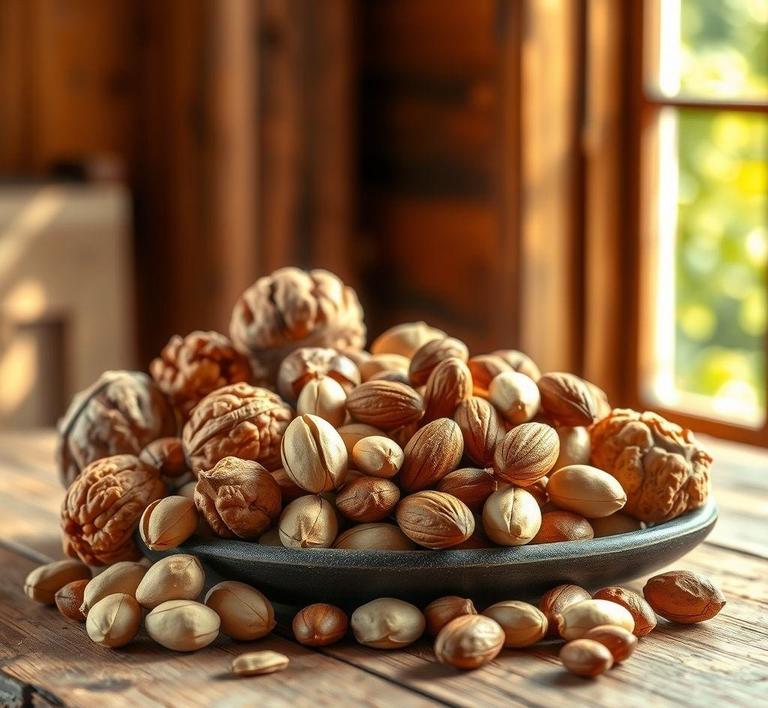If you’ve ever wondered whether you can refreeze nuts after they’ve been thawed, you’re not alone! Many people don’t realize that, while freezing nuts can help extend their shelf life, the process of refreezing them might not always be ideal for preserving their texture and flavor. However, if you do it the right way, you can still enjoy them without too much of a difference. This guide will walk you through the do’s and don’ts of refreezing nuts, so you can make sure you’re getting the most out of your pantry staples without compromising quality.
Can You Refreeze Nuts?

When it comes to refreezing foods, especially those with delicate textures and oils like nuts, the process can raise some concerns. So, can you refreeze nuts? Technically, yes-you can refreeze nuts. However, whether it’s a good idea depends on how they’ve been handled and the quality you expect from them afterward.
Nuts are typically frozen to extend their shelf life, maintain freshness, and preserve their natural oils, which can otherwise go rancid. When nuts are initially frozen, they lock in moisture and nutrients, and the freezing slows down the processes that lead to spoilage. This is why they are commonly stored in freezers, especially in bulk or when you’re not planning to use them immediately. But once you’ve thawed them, you can refreeze them, but there are some caveats.
Freezing and thawing foods several times can disrupt their structure, and this is especially true for nuts. Unlike other foods that are more resilient to freezing, nuts can suffer from changes in texture, flavor, and overall quality when subjected to multiple freeze-thaw cycles.
How To Refreeze Nuts?
If you find yourself in a situation where you need to refreeze nuts, there are a few crucial steps to follow to minimize damage to their quality:
-
Ensure Proper Thawing:
The first key step is to ensure the nuts are properly thawed before refreezing them. If you simply leave them out at room temperature, it can cause moisture to form on the surface, which could negatively affect their texture and flavor. It’s best to thaw them in a cool, dry place, and preferably on a clean, dry paper towel to absorb excess moisture.
-
Check for Signs of Spoilage:
Before refreezing any nuts, inspect them carefully. Nuts can go rancid if left at room temperature for too long, and refreezing already spoiled nuts will only worsen their condition. Make sure the nuts are fresh and free from any off smells or visible mold before placing them back into the freezer.
-
Use Airtight Containers:
Moisture is a major enemy of frozen nuts, so you want to keep air and moisture away as much as possible. Use airtight containers or resealable freezer bags to store the nuts. For extra protection, consider double-bagging the nuts to ensure they remain dry and protected from freezer burn.
-
Freeze in Small Portions:
Instead of refreezing a large batch all at once, it’s better to divide the nuts into smaller portions that can be used as needed. This reduces the number of times you open the container and expose the nuts to air, which can cause them to degrade faster. Small portions also help maintain better freshness each time you open them.
-
Label and Date the Nuts:
It’s always a good idea to label your containers with the date of freezing. This allows you to track how long the nuts have been stored and helps you use them within an optimal timeframe. Nuts can typically be kept in the freezer for up to six months, but they are best used within a month or two after refreezing to ensure quality.
Quality Impact
Refreezing nuts can have a significant impact on their quality, particularly in terms of texture and flavor. Let’s break down the potential effects:
-
Texture Changes:
Nuts contain natural oils, and when they are frozen and thawed multiple times, the oils can begin to separate. This can lead to a slightly more oily or greasy texture. Furthermore, the freezing process can cause the cell walls within the nuts to rupture, especially if they are high in moisture content. This leads to a softer, sometimes chewy texture, which can be unappealing, particularly in nuts that are typically crisp like almonds, cashews, or peanuts.
-
Flavor Deterioration:
Nuts are packed with delicate flavors and oils that give them their characteristic taste. When nuts are repeatedly frozen and thawed, the flavor can degrade, becoming stale or rancid. This is especially true for nuts that have been stored improperly before freezing or those that have already started to age. Additionally, the freezing process may cause some loss of aromatic compounds that contribute to the freshness of the flavor.
-
Freezer Burn:
One of the biggest risks of refreezing nuts is freezer burn, which occurs when moisture escapes from the food, causing dehydration and a loss of flavor. While this isn’t a huge issue with airtight packaging, repeated freezing and thawing increases the chance that some of the nuts may become dried out or develop unpleasant freezer burn, leaving them with an off flavor or texture.
-
Rancidity:
Nuts are rich in fats, and while freezing does slow the process of fat oxidation, it doesn’t stop it completely. When nuts are repeatedly frozen and thawed, they may begin to develop a rancid taste, which is caused by the breakdown of oils. If you notice a sour or unpleasant odor, it’s a sign that the oils in the nuts have begun to turn, and consuming them could lead to stomach discomfort.
While it’s possible to refreeze nuts, it’s not always the best option if you want to preserve their quality. Nuts are delicate, and frequent freezing and thawing can lead to undesirable changes in both texture and flavor. However, if you must refreeze nuts, there are ways to minimize the impact on quality, such as ensuring proper thawing, using airtight storage, and checking the freshness before refreezing.
If you’re someone who regularly buys in bulk or has leftover nuts from a recipe, freezing them once is a great strategy to extend their shelf life. But if you find that you’re constantly refreezing them, it might be worth reconsidering how you store them in the first place to reduce the need for repeated freezing. Ideally, you should aim to consume nuts within a couple of months after freezing them to enjoy their full flavor and texture.
Lastly, if you do choose to refreeze nuts, just be mindful of the changes that may occur. Keep in mind that some loss of quality is inevitable, and while they may still be safe to eat, they might not have the same delightful crunch or taste as when they were fresh.
Is It Safe To Refreeze Nuts?
Nuts are a beloved snack, full of healthy fats, proteins, and essential nutrients. They can be enjoyed in a variety of ways, whether eaten on their own, added to salads, or used in baking. But what happens if you’ve frozen a batch of nuts and later realize you don’t need them all at once? Can you safely refreeze them?
The short answer is yes, it is generally safe to refreeze nuts as long as they have been handled properly, but there are some important caveats to keep in mind. Freezing nuts does not significantly alter their quality in terms of texture or taste, and their nutritional content is largely preserved. However, the refreezing process can impact the flavor and texture if not done carefully.
The key to refreezing nuts safely lies in how you thaw and refreeze them. When nuts are thawed, they undergo a shift in moisture content. The process of freezing and thawing causes condensation to form inside the nut, which can lead to changes in texture, especially if they are not stored airtight. Once nuts have been exposed to air or moisture, refreezing them could result in a loss of their natural crispness, causing them to become soggy or stale when thawed again.
Signs That Nuts Should Not Be Refrozen
While it may be tempting to refreeze nuts if you’ve thawed too many, there are certain signs that indicate they should not be refrozen. It’s important to pay attention to these signs to avoid ruining your batch and consuming nuts that could potentially harm your health.
- Off or rancid odor: Nuts contain oils that can go rancid when exposed to air. If you notice a sour, bitter, or ‘off’ smell after thawing the nuts, it’s best to avoid refreezing them. Rancid nuts can taste unpleasant and may even cause digestive issues if consumed.
- Visible moisture or condensation: When nuts are thawed, they may sweat, especially in humid environments. If you notice moisture pooling in the packaging or on the surface of the nuts, this is a sign that they’ve absorbed excess water during the thawing process. Moisture is a major contributor to freezer burn and will affect the quality of the nuts, so it’s best not to refreeze them under these conditions.
- Changes in texture: If the nuts feel soft, mushy, or stale after thawing, it’s a clear indication that they’ve already undergone changes that could be further aggravated by refreezing. Nuts that lose their crunch or become chewy lose much of their appeal and are better disposed of than refrozen.
- Signs of freezer burn: Freezer burn occurs when food has been exposed to air and moisture in the freezer. You’ll recognize it by the presence of dry, whitish patches on the nuts. Freezer burn ruins texture and taste, and it can make the nuts unappetizing. If you spot freezer burn, it’s best to discard them rather than refreezing.
- Time and temperature concerns: If the nuts have been left out for too long at room temperature (more than two hours) or have thawed and been sitting in a warm area for an extended period, refreezing can cause the growth of harmful bacteria. Always monitor the thawing process to ensure it doesn’t last too long before freezing them again.
Common Refreezing Mistakes
When it comes to refreezing nuts, there are some common mistakes people make that can result in poor quality or even spoilage. Avoiding these errors can help you preserve the integrity of your nuts and keep them tasting fresh.
- Not using airtight storage: One of the most common mistakes is not properly sealing nuts before refreezing. If nuts are stored in a container that’s not airtight, they’ll be exposed to moisture and air, which can accelerate the deterioration of their texture and taste. Always use vacuum-sealed bags or airtight containers to protect them.
- Thawing at room temperature: Thawing nuts too quickly by leaving them out at room temperature can cause them to sweat and lose moisture. A better approach is to thaw them slowly in the refrigerator or on the counter in a dry, well-ventilated area. This reduces the risk of moisture buildup that can degrade their quality when refrozen.
- Refreezing multiple times: Repeated freezing and thawing is a major no-no for maintaining the quality of nuts. Every time you freeze and thaw them, their flavor and texture degrade, and the risk of bacteria growth increases. It’s best to only refreeze nuts once and only if you’ve thawed them safely and haven’t exposed them to too much moisture.
- Refreezing nuts that are already roasted: Roasted nuts, when frozen, can lose much of their crispness and texture after being thawed and refrozen. Roasting already changes their structure, and refreezing will only further degrade them. If you’ve roasted your nuts, it’s best to freeze them in smaller portions to avoid having to refreeze them after thawing.
- Not labeling: When freezing nuts, always label the container with the date they were frozen. If you don’t track how long they’ve been in the freezer, you might end up refreezing them after they’ve already been stored for too long, affecting their quality.
Tips And Tricks For Refreezing Nuts
- Freeze in smaller portions: To avoid the need for refreezing, consider freezing nuts in smaller, manageable portions. This way, you can thaw only what you need and avoid thawing and refreezing large amounts.
- Use proper packaging: For optimal protection, use vacuum-sealed bags or ziplock bags with all the air squeezed out to prevent freezer burn and moisture buildup. If using containers, ensure they are completely airtight to maintain the quality of the nuts.
- Freeze raw, not roasted: If you plan to store nuts for the long term, freeze them raw rather than roasted. Raw nuts are more resilient to the freezing and thawing process, and they maintain their texture and flavor better than roasted nuts.
- Use desiccants or moisture absorbers: If you’re concerned about moisture during the freezing process, you can include a moisture absorber or desiccant pack in the container. This will help control any condensation that might form when the nuts are thawed.
- Thawing method matters: Thaw nuts slowly to reduce moisture buildup. You can place them in the fridge overnight or leave them on the counter for a few hours. Avoid rushing the thawing process by using heat, as this can cause them to lose their quality.
Conclusion
Refreezing nuts can be done, but it’s not always the best option if you want to maintain their freshness and taste. By paying attention to signs of spoilage, avoiding common mistakes, and using proper freezing and thawing techniques, you can safely refreeze nuts without sacrificing too much in terms of quality. However, it’s always a good idea to limit how often you refreeze them to preserve their natural texture, flavor, and nutritional benefits. Proper storage and careful handling can help ensure that your frozen nuts are still enjoyable when you’re ready to use them again!


